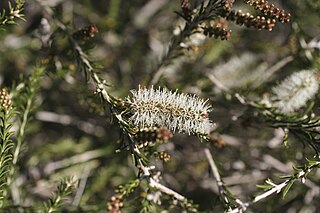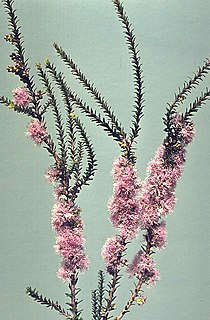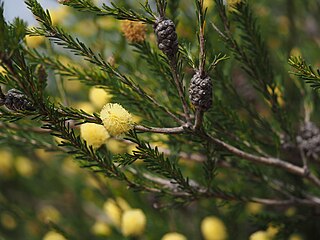
Eucalyptus erythronema, commonly known as the red-flowered mallee, is a species of mallee or tree and is endemic to Western Australia. It has smooth, dark pink to red bark that is shed to reveal whitish bark, and has lance-shaped adult leaves, pendulous flower buds mostly arranged in groups of three, red or yellow flowers and conical fruit.
Verticordia carinata, commonly known as pea-shaped featherflower or Stirling Range featherflower, is a flowering plant in the myrtle family, Myrtaceae and is endemic to Western Australia. It is an erect, spindly shrub with small, well-spaced leaves and pink and red flowers. It is a rarely seen plant, not known between its description in 1849 and its rediscovery in 1990.

Darwinia leiostyla is an erect shrub in the family Myrtaceae and is endemic to the south-west of Western Australia. It typically grows to a height of 0.3–1.5 m and has linear leaves up to about 10 mm (0.39 in) long crowded along the branches. Pendent, bell-shaped, flower-like inflorescences appear from May to January. These are clusters of small flowers surrounded by larger pink, red or white, petal-like bracts.

Verticordia fastigiata, commonly known as mouse featherflower, is a flowering plant in the myrtle family, Myrtaceae and is endemic to the south-west of Western Australia. It is a prostrate or low shrub with small, club-shaped leaves and mouse-scented flowers which vary in colour from golden-yellow and orange to dark red.

Melaleuca adnata, commonly known as sandhill honey-myrtle, is a plant in the myrtle family, Myrtaceae and is endemic to the south-west of Western Australia. It is a tall shrub with papery bark and spikes of white flowers in spring and early summer.

Melaleuca laxiflora, commonly known as narrow-leaved paperbark, is a woody, spreading shrub in the myrtle family, Myrtaceae and is endemic to the south-west of Western Australia. It is distinguished by its loosely arranged, mostly lateral pink flower spikes and its smooth, fleshy, oil-dotted leaves. It is often cultivated because of its hardiness and attractive flowers.

Melaleuca bracteosa is a low, spreading shrub in the myrtle family, Myrtaceae and is endemic to the south-west of Western Australia. It has tiny, fleshy, non-prickly leaves and cream flowerheads.

Melaleuca cucullata is a large shrub in the myrtle family, Myrtaceae and is endemic to the south-west of Western Australia. Its species name alludes to the shape of the leaves which resemble miniature academics' hoods.

Melaleuca depauperata is a shrub in the myrtle family, Myrtaceae and is endemic to the south-west of Western Australia. It has small, fleshy leaves and purple to pink flowers on short stalks along the branches.

Melaleuca lutea is a plant in the myrtle family, Myrtaceae and is endemic to Western Australia. This species was previously known as Melaleuca citrina but was renamed to allow Callistemon citrinus to be moved to the genus Melaleuca. It is distinguished by its oval shaped, dense heads of yellow flowers and bushy foliage.
Calothamnus affinis is a plant in the myrtle family, Myrtaceae and is endemic to the south-west of Western Australia. It is an erect, compact, or spreading shrub with red to purple flowers in spring.

Verticordia fimbrilepis, commonly known as shy featherflower, is a flowering plant in the myrtle family, Myrtaceae and is endemic to the south-west of Western Australia. It is a small, bushy shrub with one openly branched main stem at its base, small, pointed leaves and rounded groups of pink flowers near the ends of the branches.

Beaufortia puberula, commonly known as hairy-leaved beaufortia, is a plant in the myrtle family, Myrtaceae and is endemic to the south-west of Western Australia. It is a shrub growing to a height of about 2 m (7 ft) with hairy young leaves and heads of hairy, pink or red flowers during most of the year.

Eucalyptus celastroides, commonly known by the Noongar name of mirret, is a species of eucalypt that is endemic to the south-west of Western Australia. It is a mallee, rarely a tree, and has rough bark on about half of the lower half of its tunk, smooth above, narrow lance-shaped adult leaves, flower buds in groups of seven or nine, white flowers and urn-shaped fruit.

Conothamnus aureus is a member of the family Myrtaceae and is endemic to Western Australia. It is a spindly, straggly shrub with rigid, blunt leaves and spherical heads of golden yellow flowers resembling those of wattles.

Leptospermum incanum is a species of compact shrub that is endemic to Western Australia. It has hairy young stems, elongated egg-shaped leaves on a short petiole, relatively large white or pink flowers and fruit that fall from the plant when mature.

Leptospermum nitens is a species of slender shrub that is endemic to Western Australia. It has thin, fibrous bark, narrow egg-shaped to wedge-shaped leaves, white or pink flowers on short side branches and fruit with the sepals attached but that falls from the plant shortly after the seeds reach maturity.

Leptospermum oligandrum is a species of erect, spreading shrub that is endemic to the south-west of Western Australia. It has broadly egg-shaped to wedge-shaped leaves, white flowers arranged singly or in groups of up to three on the ends of short side branches and fruit that fall from the plant shortly after the seeds are released.
Thryptomene cuspidata is a species of flowering plant in the family Myrtaceae and is endemic to Western Australia. It is a dense erect shrub that typically grows to a height of 0.6–2.2 m and blooms between July and November producing white or pink flowers.
Baeckea leptophylla is a species of flowering plant in the family Myrtaceae and is native to Western Australia.
















